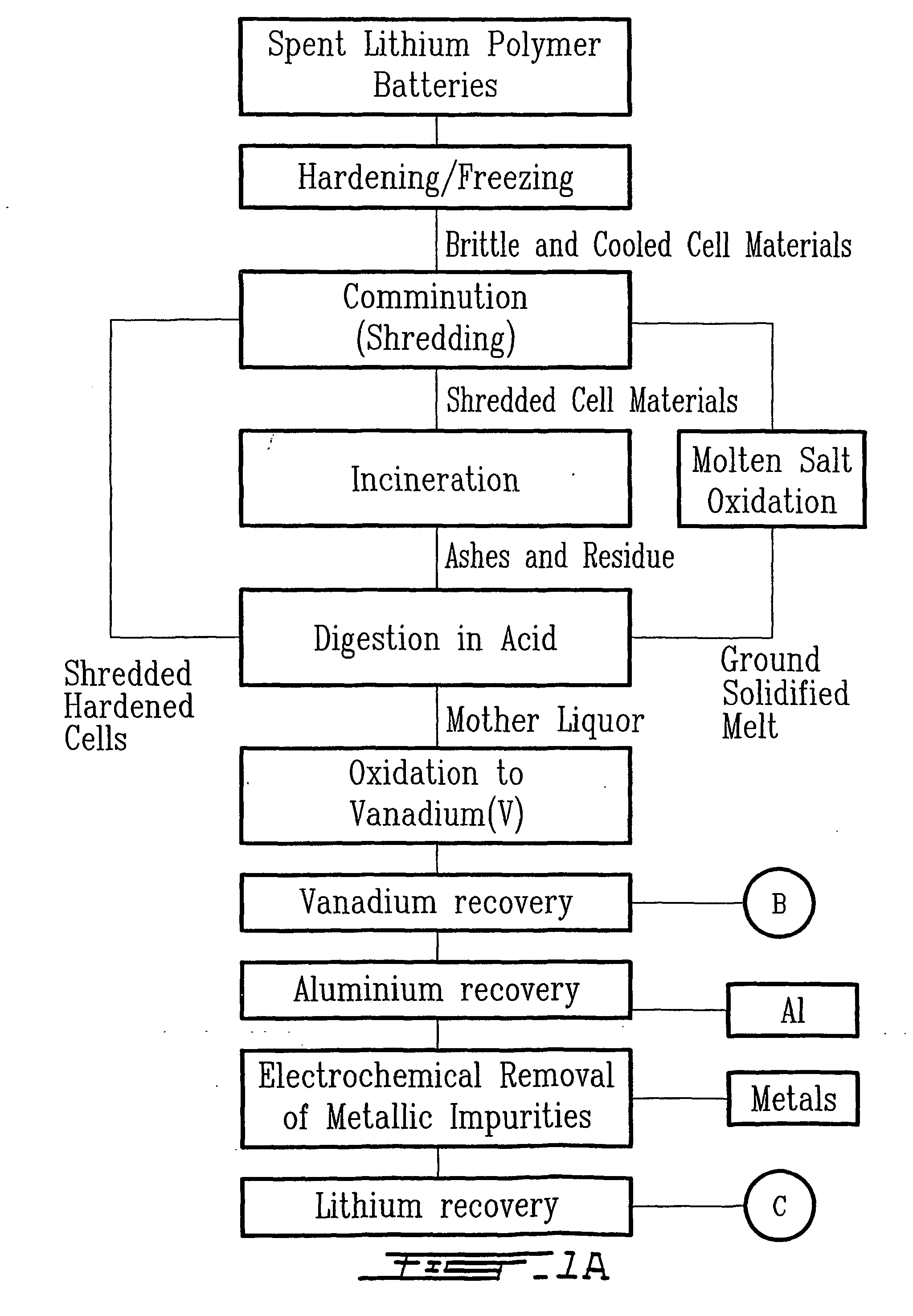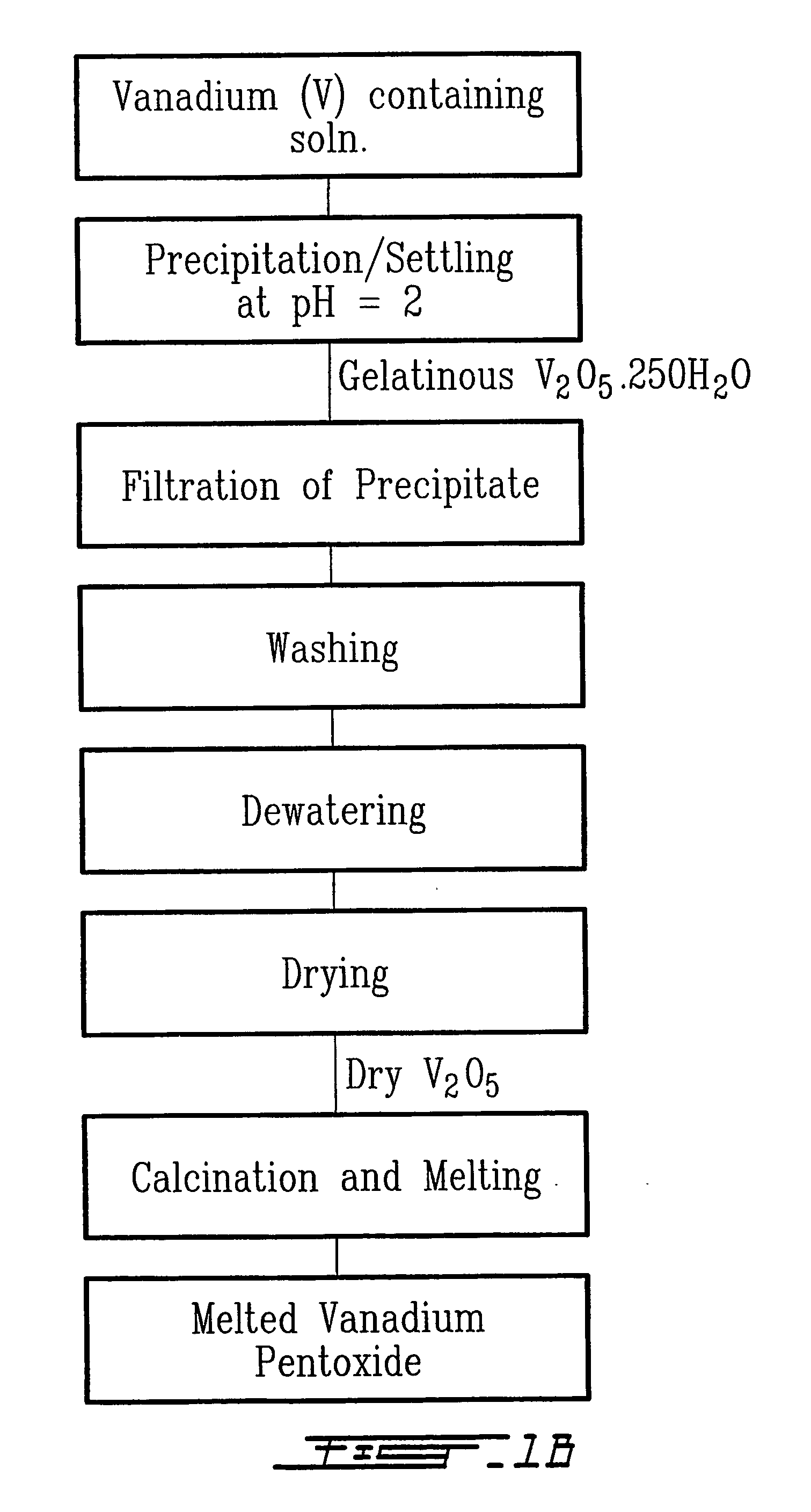Method for recycling spent lithium metal polymer rechargeable batteries and related materials
a lithium metal polymer and rechargeable battery technology, applied in the direction of lithium compounds, niobium compounds, dissolving, etc., can solve the problems of limited commercialization and limited use of lithium metal solid and gel polymer electrolyte batteries
- Summary
- Abstract
- Description
- Claims
- Application Information
AI Technical Summary
Benefits of technology
Problems solved by technology
Method used
Image
Examples
first embodiment
[0029] Extraction of vanadium, removal of heavy metals, and aluminium and lithium extraction are carried out in the same manner as in the
third embodiment
[0030] In the third embodiment, instead of batch incinerating the shredded mass, the latter is subject to batch oxidation performed in a molten salt bath.
[0031] Batch molten salt oxidation (MSO) is employed and performed in a reaction vessel made of corrosion and heat resistant alloy (e.g., Hastelloy.RTM.-X, Inconel.RTM.-617, nickel or copper clad steel, titanium and alloys, zirconium and alloys). The reaction is initiated by injecting the spent shredded mass into a molten salt bath comprising a mixture of molten alkali and alkali-earth metals inorganic salts M.sub.nX.sub.m (with M=Li, Na, K, Rb, Cs, Be, Mg, Ca, Sr, Ba and X=F.sup.-,Cl.sup.-, Br.sup.-, I.sup.-, SO.sub.4.sup.2-, NO.sub.3.sup.-, CO.sub.3.sup.2-, BO.sub.3.sup.2-, PO.sub.4.sup.3-) at temperatures between 500 K-2000 K, preferably 1000 K. Usually an exothermic and fast reaction takes place for few seconds with a peak temperature around 1500K. Afterwards, the temperature is maintained constant at 1000K during 8 hours. It w...
example 1
[0035] (Incineration of ECs and Digestion of Ashes)
[0036] The first step consisted in rendering more brittle and easy to comminute a mass of one kilogram of spent electrochemical cells (ECs) having the chemical composition listed in Table 1. The electrochemical cells exhibited various states of charge. Hardening occurred by immersing the spent ECs directly into liquid argon maintained at 85 K. The dimensionless ratio, denoted r.sub.AE, is the mass of liquid argon required per unit mass of ECs and it was calculated by the following equation listed below: 1 r AE =m A rm EC =c PEC ( T EC - T F ) c PA r ( T F - T A r)
[0037] where m.sub.Ar and m.sub.EC are the masses expressed in kg of liquid argon and spent ECs respectively, c.sub.PAr, and c.sub.PEC are the specific heat capacities expressed in J.kg.sup.-1.K.sup.-1 of liquid argon and spent ECs respectively, and T.sub.Ar, T.sub.EC, and T.sub.F are temperatures expressed in kelvin of liquid argon, spent ECs, and the final temperature all...
PUM
| Property | Measurement | Unit |
|---|---|---|
| Temperature | aaaaa | aaaaa |
| Temperature | aaaaa | aaaaa |
| Temperature | aaaaa | aaaaa |
Abstract
Description
Claims
Application Information
 Login to View More
Login to View More - R&D
- Intellectual Property
- Life Sciences
- Materials
- Tech Scout
- Unparalleled Data Quality
- Higher Quality Content
- 60% Fewer Hallucinations
Browse by: Latest US Patents, China's latest patents, Technical Efficacy Thesaurus, Application Domain, Technology Topic, Popular Technical Reports.
© 2025 PatSnap. All rights reserved.Legal|Privacy policy|Modern Slavery Act Transparency Statement|Sitemap|About US| Contact US: help@patsnap.com



